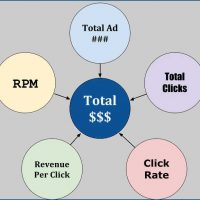
Best Website Content Strategy Produces Hefty Revenue
The best website content strategy produces more revenue and audience when it is both deep and broad.
“Content is King” is a well-known saying when online publishers debate how to succeed at growing profits and revenue. But the saying doesn’t really say much. (more…)

Effective Online Advertising Delivers Measurable Results
Effective online advertising emphasizes both branding and response. Its effectiveness is highly measurable.
The branding part comes in the form of text and multimedia. The multimedia is a photo, graphic, audio, video, company logo or some combination of the above. (more…)

Simple Chart Puts Monthly Page Views into Context
A simple chart offers useful insights about monthly page views and revenue based on the time of the year.
Just comparing the most recent month with the previous month is often misleading because it takes the numbers out of context. It also ignores factors that vary from month to month but often don’t vary from year to year. (more…)

Business Productivity Separates Success From Failure
Business productivity helps Google, Facebook and other online companies succeed at what they do. Small websites can do the same.
Productivity is an old word in business. It’s another way of describing efficiency, especially cost efficiency. (more…)

Contextual Ads Need Help From Contextual Content
Contextual ads from Google AdSense will deliver high CPMs and click-through rates if they appear with content that provides the right context.
What are contextual advertising banners? They are ads whose subject matter is determined dynamically by the site content that surrounds it. (more…)

Online Sales Report Gives 6 Insights for Success
Websites large and small benefit greatly from a good online sales report. It’s a high-yield tactic that requires little time and effort.
Even the smallest website will find useful insights from a simple report tracking sales performance. (more…)

What is Page RPM? It Signals Chance for Revenue Growth
Page RPM or revenue per thousand page impressions is a publisher metric that measures revenue the way that CPM measures cost for advertisers.
The metric is a simple formula that divides the amount of website revenue by the number of impressions, which also are divided by 1,000. (more…)
 Promise Media offers online business tips and best practices for content-rich websites.
Promise Media offers online business tips and best practices for content-rich websites.